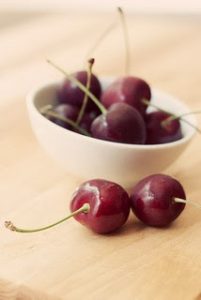
This is the third and final post in a series on some of the most glorious plant families of the summer garden and orchard. Part 1 covered cucurbits, and part 2 discussed nightshades. Today the drupes of the Prunus family have their turn.
The genus Prunus includes plums, apricots, cherries, and peaches, among other stone fruits. This type of fruit, a fleshy mass surrounding a large pit, is called a drupe. Drupe comes from the Greek word for olive, a fine representative of the type.
The plums we eat are generally Prunus domestica. The Greeks called them prounon, and the Romans called them prunus. The Latin name worked its way into Germanic languages with an R instead of an L, giving us the word plums, at least when they’re fresh. The dried ones are prunes, although I understand that this word has become so firmly associated with constipation and old age that the prune-sellers are pushing the term “dried plums.” Plums gave their name to the entire Prunus genus.
The Romans called peaches malum Persicum, for Persian apple; the scientific name retains the Persian attribution: Prunus persica, or Persian plum. Although the Romans obviously thought that the peach came from Persia, its genes tell a different story: it probably came from China before making its way to Persia and thence to the Romans and eventually the rest of us. Time changed the shortened Latin name persica to pessica and then to pesca; at that point (medieval Latin), it made its way into French as peche, and then into English as peach.
The peach shares a subgenus, Amygdalus, with the almond. (If you look inside a peach pit, you’ll see a little kernel that bears more than a passing resemblance to an almond. This kernel contains a compound that can decompose into hydrogen cyanide. Opinions differ on how dangerous these things are to consume, but I’m going to play it safe and advise you not to eat them, feed them to the dog, or otherwise oversee their ingestion.) I mention the Amygdalus subgenus so that I can also mention that the amygdala in your brain got its name because it’s almond-shaped.
Apricots are currently Prunus armenaica (which translates as Armenian plum), but their first official botanical name was Mala armenaica (another apple!). Again, though, they actually originated in China. The English name comes from the Latin word praecoquis by a very circuitous route. The Latin word means “early ripening”; apricots were originally thought to be a type of peach that ripened earlier than the peaches people already knew about. From Latin, the word traveled into Greek, where it sprouted a variant plural form, berikókkia. Arabic borrowed that word as barqūq, and that’s the name that southwestern Europe got hold of during the period of Muslim rule in the Iberian peninsula. The word entered English as abrecock, probably from a Spanish variant on the Arabic term. French picked it up, probably from the same source, as abricot, and that spelling likely influenced the shift in the English word to its present form in the late 16th century. Whew!
Cherry has a much simpler story: from Greek kerasós to Latin ceresia or cerasia and on into Old French as emcherise (and thence to today’s French word for this fruit, cerise). The English word lost the s at the end because it was misconstrued as indicating the plural. Something similar happened to pease, which was originally a collective (non-count) noun, like interference, that could be used as a singular noun if you needed to refer to a single pea. However, because people took it for a plural word, the singular word pea was formed from it. Anyway, the cherries we eat are generally either Prunus avium (the sweet kind) or Prunus cerasus (the sour kind). Prunus avium can be translated as bird cherry, which will make a lot of sense to anyone who has had to share a cherry tree with the birds.
One last note, and a brief foray into another genus. The genus Prunus is in the family Rosaceae, which contains not just roses but apples and pears, and also the genus Rubus, which contains raspberries and blackberries. This is one of my very favorite groups of summer fruits. Not only are raspberries among the most luscious and luxurious of summer edibles, they’re representatives of a type of fruit with a cool name: drupelets. They’re called that because they consist of many small drupes.
It’s a little late for any of these drupes at the Farmer’s Market in my part of the country; I saw peaches and plums and even raspberries a couple of weeks ago, but they’re probably about finished. If you’re lucky enough that these summer yummies are still around, enjoy them in all their fresh local splendor.
Learn more:
- Determined gardeners might like to see the list of all the plants in the genus Prunus at Dave’s Garden.
- If you are hoping to find your own local cucurbits, nightshades, and drupes, you might be interested in Local Harvest, which will help you find Farmer’s Markets, CSAs, and more in your area.